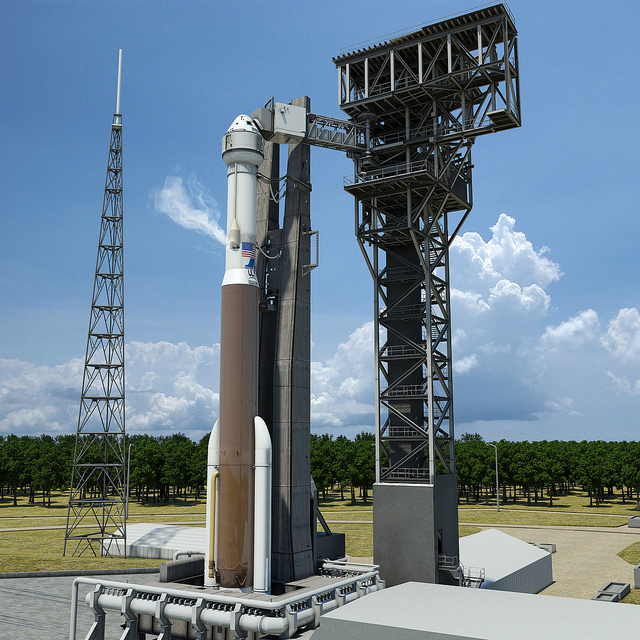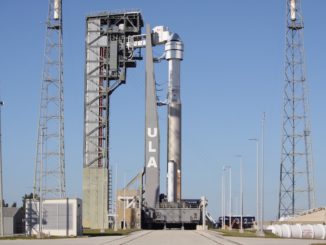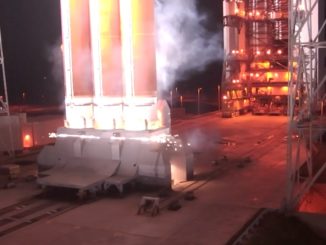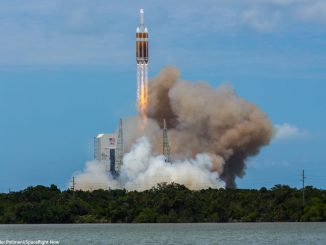
A new fixture on the Cape Canaveral skyline began rising Tuesday, with the placement of the first of seven segments for a 200-foot-tall crew access tower at the Atlas 5 rocket’s seaside launch pad for astronauts boarding Boeing’s new commercial CST-100 Starliner spaceship.
The first two tiers of the tower transferred to the Atlas 5 rocket’s Complex 41 launch pad Sept. 9, and a giant crane at the launch site positioned the first segment over the structure’s concrete foundation Tuesday, according to a United Launch Alliance spokesperson.
Construction crews assembled the seven tiers at a nearby worksite beginning earlier this year, and now attention turns to stacking the tower at Complex 41.
Astronauts flying into space aboard the CST-100 Starliner crew capsule will ride an elevator up the tower and then crawl into the spacecraft through a climate-controlled enclosure called a white room.
Boeing is developing the CST-100 Starliner spacecraft under contract to NASA, which awarded the aerospace giant an agreement worth up to $4.2 billion to finish certification of the crew capsule and fly up to six full-up crew ferry flights between Earth and the International Space Station.
NASA signed a similar contract SpaceX worth up to $2.6 billion for the Crew Dragon spaceship outfitted for humans. SpaceX’s crewed flights will take off on Falcon 9 rockets from a decommissioned space shuttle launch pad currently being modified for the purpose.
The commercial crew program will end U.S. reliance on Russian Soyuz spacecraft to carry crews to the space station.
Engineers are using down time in the Atlas 5 rocket’s busy launch manifest to build up the crew access tower at Complex 41, according to Howard Biegler, head of human launch services at ULA, the Boeing-Lockheed Martin joint venture which builds and operates the Atlas 5.
“All seven tiers, which make up the center core of the crew access tower, are fully constructed,” Biegler said in an interview with Spaceflight Now. “The towers are fully outfitted. We’ve got stairwells, all the piping, fire extinguishers, elevator shafts, you name it.”
Construction crews at the launch pad, situated a half-mile from the Atlantic shoreline, have built up a crane to lift the tower segments.

The launch pad will not have a permanent tower until the crew access structure is erected. The Atlas 5 rocket is built up on a mobile platform inside a nearby vertical integration facility, then rolled out to the launch pad the day before liftoff.
Biegler said the plan calls for all seven segments to be hoisted by the time of the Atlas 5’s scheduled launch of a new GPS navigation satellite Oct. 30. Some of the tiers will go up before the Atlas 5’s next mission, which is set for Oct. 2 with a Mexican communications satellite, and ground teams will add the rest before the Oct. 30 launch.
“After our GPS launch at the end of October, all of our outboard steel which makes the top part of the tower for storing the crew access arm, emergency egress and other equipment will be added,” Biegler said.
The stacking of the crew access tower comes after teams poured 300 cubic yards of concrete for the structure’s foundation just to the northwest of where the Atlas 5’s mobile launch platform parks over the launch pad’s flame trench, according to John Mulholland, vice president and program manager for Boeing’s commercial crew program.
While workers poured the foundation, a team nearby constructed the seven 28-foot-tall 20-by-20 foot sections for the crew access tower.
Biegler said the structure will be completed by January.
“Then we’ll start running cables and outfitting it,” he said.
A 42-foot-long crew access arm is taking shape at a construction yard in nearby Oak Hill, Florida. The appendage will connect the tower to the CST-100 Starliner mounted atop the Atlas 5 rocket, allowing astronauts to board the capsule in the final hours of the countdown.
Located about 172 feet up the 20-story tower, the arm will swing away after ground teams close the Starliner hatch, clearing the way for liftoff.
“We’ve got the torque tube, the structural arm, the white room and the environmental seal, and the drive system, which we call the hydraulic drive system, will be integrated on a test stand and we’ll run it through its paces,” Biegler said. “That’s a critical path item. When we bring it out to Complex 41 in the June timeframe of next year, we want to know exactly where it’s got to be positioned on the tower, and know that everything works and the timing works perfectly.”
ULA and Boeing managers are working out the details of how to load the astronauts into the CST-100 Starliner.
Engineers evaluated Apollo- and shuttle-era white rooms, including artifacts on display at the Kennedy Space Center Visitor Complex, when designing the Starliner access arm.
“We’ve got an environmental seal on the end of it that is 7 feet by 5 feet by 5 feet on the end of (the white room),” Biegler said. “If you take that into consideration, we’re actually bigger than shuttle (white room), but for the most part, it’s comparable.”
A closeout crew similar to the team that strapped astronauts into the space shuttle will be at the launch pad to help crew members into the CST-100 Starliner. The ground team will likely be a mix of ULA, Boeing and NASA personnel, but the exact makeup has not been finalized, according to Biegler.
“We’re going to have as few people out there as we need to make it efficent because we want to be able to get this done in a quick manner, and get them out,” Biegler said.
“It’s also pretty hazardous,” said Tony Taliancich, director of ULA’s east coast operations. “We don’t want to take any more risks than we need to take. We’ll have a fully loaded vehicle with hydrogen and oxygen, and be ready to launch at that point.”
The Atlas 5 launch team will fuel the rocket with propellants before the astronauts arrive at the pad. A built-in hold at T-minus 4 minutes, which usually lasts a few minutes, will be extended up to three hours to give the crew time to get into the capsule.
“In our normal process, we’re within four minutes of launching at that point, so we’re just waiting for the astronauts to get on-board,” Taliancich said.
The CST-100 Starliner can carry up to seven astronauts, but the capsule’s standard mission will likely include a crew of four plus supplies for the space station.
Another feature of the crew access tower will be a slidewire escape system similar to the emergency egress baskets used at the space shuttle launch pads.
Boeing’s capsule will fly on a version of the Atlas 5 with two solid rocket boosters, a dual-engine Centaur upper stage, and an emergency detection system to detect faults in flight and trigger an abort, if necessary.
Officials said all of the crew access tower construction should be completed by late 2016, in time for the first uncrewed CST-100 Starliner test flight scheduled for May 2017, and the first human demonstration mission in September 2017.
Email the author.
Follow Stephen Clark on Twitter: @StephenClark1.



